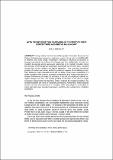Files in this item
With or without you. Partnership context of first conceptions and births in Hungary
Item metadata
| dc.contributor.author | Mikolai, Julia | |
| dc.date.accessioned | 2017-01-19T09:30:13Z | |
| dc.date.available | 2017-01-19T09:30:13Z | |
| dc.date.issued | 2012 | |
| dc.identifier.citation | Mikolai , J 2012 , ' With or without you. Partnership context of first conceptions and births in Hungary ' , Demográfia English Edition , vol. 55 , no. 5 , pp. 37-60 . < http://demografia.hu/en/publicationsonline/index.php/demografiaenglishedition/article/view/210 > | en |
| dc.identifier.other | PURE: 248906992 | |
| dc.identifier.other | PURE UUID: caa67bf5-746a-4d27-ba24-28cf28f89f47 | |
| dc.identifier.other | ORCID: /0000-0002-7733-6659/work/48516890 | |
| dc.identifier.uri | https://hdl.handle.net/10023/10124 | |
| dc.description | The author is grateful for the financial support received from the Netherlands Interdisciplinary Demographic Institute (NIDI) while participating in EDSD. The current version of this paper was prepared while the author was a PhD student at the University of Southampton, funded by the Economic and Social Research Council (ESRC). I am grateful for the financial support I received from the Centre for Population Change (CPC) at the University of Southampton. | en |
| dc.description.abstract | Using notions from the Second Demographic Transition theory and the Pattern of Disadvantage argument, I study how women’s risk of a first conception within different union types (single, cohabitation, marriage) is influenced by education in Hungary and whether this influence has changed over time. Additionally, I examine the transition to marriage among women who experienced a non-marital conception. Using the first wave of the Hungarian Generations and Gender Survey from 2004, I conduct discrete time survival analyses and logistic regression. I find a positive educational gradient of marital conceptions, while this gradient is negative for cohabiting conceptions. Moreover, highly educated women are less likely to experience a cohabiting or a single conception than a marital conception compared to their medium educated counterparts. Furthermore, the impact of education on the risk of a single and marital conception changes over time. The positive gradient of education on the risk of a single conception emerged after the transition, while it declined for marital conceptions. No consistent patterns are found for cohabiting conceptions. Additionally, highly educated women and those who experienced a conception while being single are more likely to marry than their lower educated counterparts and those who experienced a cohabiting conception. | |
| dc.language.iso | eng | |
| dc.relation.ispartof | Demográfia English Edition | en |
| dc.rights | © 2012, Publisher / the Author. This work has been made available online in accordance with the publisher’s policies. This is the final published version of the work, which was originally published at: http://demografia.hu/en/publicationsonline/index.php/demografiaenglishedition/article/view/210 | en |
| dc.subject | Family Planning | en |
| dc.subject | Motherhood (J13) | en |
| dc.subject | Family | en |
| dc.subject | Marriage | en |
| dc.subject | Marital | en |
| dc.subject | Marital dissolution | en |
| dc.subject | First conception | en |
| dc.subject | First birth | en |
| dc.subject | Partnership context | en |
| dc.subject | Competing risks | en |
| dc.subject | Hungary | en |
| dc.subject | Cohabitation | en |
| dc.subject | Single | en |
| dc.subject | Behaviours | en |
| dc.subject | Survey | en |
| dc.subject | 2004 | en |
| dc.title | With or without you. Partnership context of first conceptions and births in Hungary | en |
| dc.type | Journal article | en |
| dc.description.version | https://doi.org/Publisher PDF | en |
| dc.contributor.institution | University of St Andrews. Geography & Sustainable Development | en |
| dc.description.status | Peer reviewed | en |
| dc.identifier.url | http://demografia.hu/en/publicationsonline/index.php/demografiaenglishedition/article/view/210 | en |
This item appears in the following Collection(s)
Items in the St Andrews Research Repository are protected by copyright, with all rights reserved, unless otherwise indicated.

